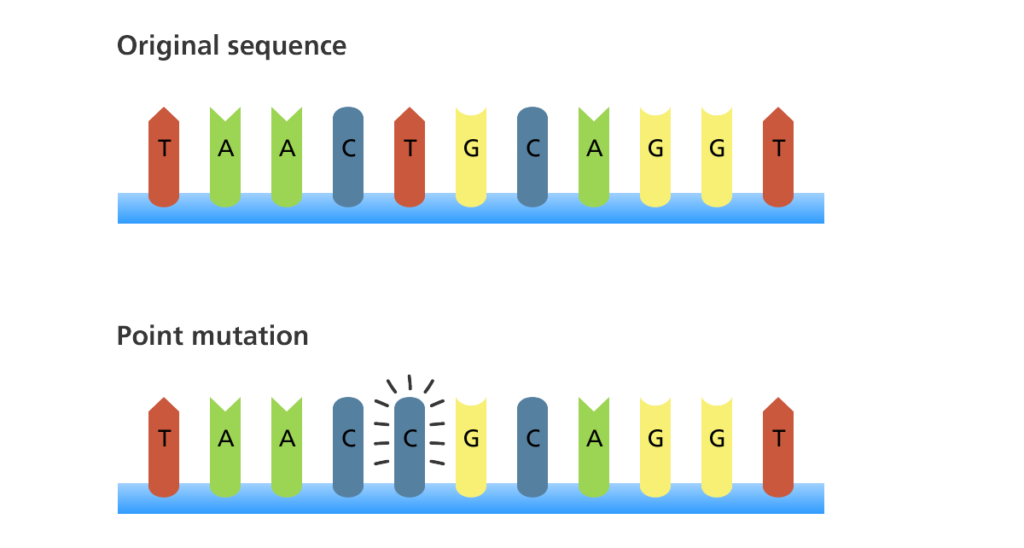How Do Mutations Affect the Products of Dna Replication
View the full answer. Replicating all of the DNA in a single human cell takes several hours of just pure copying time.

Dna Mutations Biology For Majors I
A frameshift mutation changes the reading frame through insertions or deletions to produce an entirely novel product.

. Helicase opens up the DNA at the replication fork. Changes within the DNA molecule are referred to as point mutations since they occur in a small portion of the DNA but may still have significant effect because they change the meaning of the code. A mutation is a change in DNA the hereditary material of life.
Here we reveal the genetic consequences of replicationtranscription collisions in actively dividing bacteria to be two classes of mutations. Mutation in chromosome may change the way genes are expressed. How do mutations affect the products of dna replication.
For example DDT resistance in insects is sometimes caused by a single mutation. When the mutant cells are warmed to this temperature their daughter chromosomes remain intertwined after DNA replication and. Changes in the DNA sequence of a gene can lead to changes in the protein it codes for.
Mutations can be of many types such as substitution deletion insertion and translocation. The same reaction also prevents the severe DNA tangling problems that would otherwise arise during DNA replication. Mutations are due to changes occurring within DNA itself or in the replicationcell division process.
Only mutations in germ cells eggs or sperm can be passed to offspring. Mutations can be spontaenous or can occur during the process of replication of DNA. Duplicationsdeletions and base substitutions in.
Detrimental mutations known as lethals disrupt DNA critical to survival and cause the death of the organism. Mutations in repair genes may lead to serious. A mutation in a coding sequence may alter the sequence and function of the protein product.
The DNA sequence of a gene determines the amino acid sequence of the resulting protein. DNA replication is important for creating identical copies of DNA for the new daughter cells produced during cell division. An organisms DNA affects how it looks how it behaves and its physiology.
The sequence of amino acids in a protein determines its function. According to chegg rules we can answer only the first four questions. This role is nicely illustrated by mutant yeast cells that produce in place of the normal topoisomerase II a version that is inactive at 37C.
An insertion mutation occurs when an extra nucleotide is added to the DNA strand during. Insertions and deletions are two other types of mutations that can affect cells at the gene level. Single-strand binding proteins coat the DNA around the replication fork to prevent rewinding of the DNA.
Briefly the DNA in our cells is translated by cell machinery to make proteins. They make different strands they make rna. At the end of this process once the DNA is all replicated the cell actually has twice the amount of DNA that it needs and the cell can then divide and parcel this DNA into the daughter cell so that the daughter cell and the parental cell in many.
A mutation is defined as any change in the Deoxyribonucleic Acid DNA sequence of an organism. DNA stores genetic information. They make identical strands.
A mistake occurs in replication once every 100000000 times. Mutations are essential to evolution. By the Understanding Evolution team.
Sometimes during DNA replication a base is inserted deleted or substituted with a different one changing the DNA sequence of a gene. Mutation within a gene alters the recipe for protein. DNA polymerase can make mistakes while adding nucleotides.
Beneficial effect Other mutations are helpful to the organisms that carry them. Mutagens can be anything from x-ray radiation to chemicals. Most mistakes are corrected but if they are not they may result in a mutation defined as a permanent change in the DNA sequence.
DNA ligase joins the Okazaki fragments together into a single DNA molecule. Codons are a sequence of three nitrogen bases in a row that are read by messenger RNA during transcription. It plays a vital role in life on this planet.
In any case error in DNA replication is there. There are changes in one base-pair of DNA it could be addition or deletion of bases as well. DNA is responsible for all the physical traits that make you function as a human organism.
Mutations result either from errors in DNA replication or from the damaging effects of mutagens such as chemicals and radiation which react with DNA and. They do not affect the products. That messenger RNA codon is then translated into an amino acid that goes on to make a protein that will be.
This is called a mutation. Mutations alter A-T and G-C base pairs in DNA. There could be point mutations which do not affect appearance of chromosome.
So a change in an organisms DNA can cause changes in all aspects of its life. The story of personalized medicine begins with the unique DNA you inherited from your parents. These changes may happen spontaneously if there is a mistake when copying the DNA or if the DNA sequence comes into contact with some sort of mutagen.
Genes are stretches of DNA that serve as a sort of instruction manual telling your. A point mutationthe change of a single nitrogen base in a DNA sequence is usually the least harmful type of DNA mutation. DNA replication follows base-paring rules.
They are the raw material of genetic variation. Topoisomerase works at the region ahead of the replication fork to prevent supercoiling. During replication if mutation.
Thus any changes in DNA sequence can result in changes in protein function.
How Does Mutation Affect Dna Replication Socratic
What Are Some Examples Of Three Mutations And How Do They Affect The Dna Molecule Quora
Comments
Post a Comment